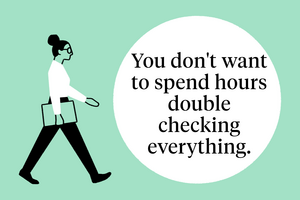In this best-of podcast, Kellogg Insight offers advice on advancing your career. We hear from Adnan Rukieh, a director of career services at Kellogg, about getting recruited, as well as faculty members Steven Franconeri, Carter Cast and Michelle Buck, who all discuss ways to hone your skills and put your best foot forward as you climb the professional ladder.
Podcast Transcript
Emily STONE: Most of us can conjure up visions of our dream job—the one that perfectly matches our skill set and ambitions, that has room to grow and learn while still respecting our desire for work–life balance.
It sounds amazing! But how do you manage to get hired for it?
In this episode of the Kellogg Insight Podcast, we revisit some of our most popular interviews offering advice on how to get recruited and promoted into positions all the way up to the C-suite.
[music interlude]
We’ll start by hearing from Adnan Rukieh. He is the Kellogg School’s Director of Career Services for executive and part-time MBA students. Before he came to Kellogg, Rukieh served as vice president of the O’Connell group, a boutique executive search firm. In other words, he was a recruiter, more popularly known as a headhunter.
Producer Jessica Love talked with Rukieh. Love started by explaining how to get on a recruiter’s radar.
Jessica LOVE: The first step is to talk to your friends and family. Who are they using and with what results? But you don’t need that personal connection—once you have compiled a list of headhunters in your industry, a cold call (or to be more precise, a cold email) works just fine.
Adnan RUKIEH: Send out an email to the recruiter; introduce yourself. Don’t expect a response. If you get a response, be ecstatic, but rest assured your resume will go into their database. Recruiters are really, really busy. They don’t have time to have coffee with you. They don’t have time to have a chat on the phone unless they’re actively searching on a role that your background fits what they’re looking for.
LOVE: Do this multiple times, to multiple headhunters. This gets you into multiple databases, increasing your chances of striking a match. It also helps you navigate conflicts of interest. If your current firm is working with an executive search firm to procure talent, you may be considered “off limits” to any recruiters from that firm.
And then, six to nine months later, reach out again.
RUKIEH: Send a revised resume, an updated note, just to make sure you’re staying top of mind with that individual. At some point, hopefully the connection exists, they have a role that fits your background, and you’re going to have a conversation about it. That’s why I say don’t wait until you’re looking for a job, because these relationships take time to build.
LOVE: So, what can you do to make that first impression as strong as possible?
For one, there’s LinkedIn. Rukieh says it has completely changed the industry. An executive search firm might turn to LinkedIn to find that third, fourth, or fifth strong candidate.
Rukieh advises that if you want to impress a recruiter and maybe make that short list yourself, it’s critical to keep your LinkedIn profile updated. But that’s just table stakes. A smart candidate can use LinkedIn to do much more.
RUKIEH: Post articles. Make statements. Show yourself as a quote–unquote “thought leader” in whatever sphere of influence you have, whatever your expertise is. If you’re a recruiter, you want to know somebody is actually at the leading edge of what they’re doing. That’s one way to signal that to the marketplace.
LOVE: Another way to make a great impression is to be helpful. If you are tapped for a particular role that you aren’t interested in or aren’t a good fit for, is there anyone in your network you can recommend? If you can offer up a few smart suggestions, you’ll make yourself look good. And even if you can’t think of any good candidates offhand, be polite. Be professional. Every time you interact with a recruiter, you are being interviewed.
RUKIEH: You better believe it. Yep, I have a checklist of things I’m thinking about: What are your interpersonal skills? What are your competencies? How do you interact? How forthcoming are you? There’s a whole litany of things that I’m evaluating, because at the end of the day, if I present to you as part of a pool of candidates, it’s now my reputation that’s on the line.
[music interlude]
STONE: Let’s say you impressed the recruiter and nailed the interview. Now you’re in a good position at a great company. You want to showcase your smarts in order to move toward the C-suite.
To do that, you will likely need present data in order to convince your bosses that you know how to streamline your company’s supply chain or launch a new marketing campaign. The best way to do this, research shows, is to present the data visually. And we’re not just talking about using charts in Excel. You need to know how to tell a clear and compelling story through data visualizations.
For advice on this, I talked with Steven Franconeri, a psychology professor at Northwestern who also teaches leadership courses at Kellogg. He started by explaining why leaders and aspiring leaders need to create effective data visualizations.
Steven FRANCONERI: It can be far superior to communicate patterns and data to people’s visual system rather than their verbal system. So the visual system lets you take in a pattern of information more deeply and more broadly, and it makes you process it more deeply. When you want people to pay attention to data—not just anecdotes or gut instincts, but data, hard numbers—it’s helpful to convey them in this visual form so that they sink in better.
STONE: Okay, so you’re ready to use a visualization to dazzle your audience. How do you go about creating it?
The first thing, Franconeri says, is to make sure that you’re telling the story you want to tell. Because when faced with data, your audience is automatically going to convert it into a story.
FRANCONERI: If you just let people stare at a complex visualization, they will make their own story, and they’ll pick different views, and they’ll pick them in an order that their brain designs, and it won’t be your story. So you need to pick a set of views and put them in order that tells the narrative that you want people to follow to understand the problem that you have and the solution that you’re proposing—so that they think about that sequence in the same way that you do in your brain.
STONE: To ensure that your story gets told, take your visualization out for a test-drive. Create a few different types of visualizations—say, a bar graph, a line graph, and a scatter chart—and then do a few iterations within those styles, testing different ways of ordering and arranging the data points within each graph.
FRANCONERI: Show those different possibilities to a few colleagues or friends and ask them what story they see in the data. You’ll be amazed at the differences.
Just imagine a simple line graph generally going up but with a few bumps in it. Just when you show something like that, there are several stories that people could be seeing in that: the fact that there are two bumps, the fact that it’s going up in general, the fact that the acceleration goes down a little bit, that the growth seems to be diminishing. You need to be able to understand what other people see in those patterns. Because once you’ve been staring at the data for many hours with your analyst hat on, you can get locked into a state where you see certain patterns, but you don’t realize that other people don’t.
STONE: There are other key rules for making a good data visualization. Make sure you give it a nice, crisp title that highlights the story you want to tell, keep the look minimalist so you aren’t providing distracting visual clutter, and be sure to guide your viewer through the data so you don’t lose anyone along the way.
FRANCONERI: Then when you take a series of those and put them in sequence—“so you should see this aspect of the data, and now, let’s switch to this aspect of the data, and this aspect of the data”—and you guide people through that sequence in a logical way, that’s a data story.
STONE: Franconeri also stresses that these visualization rules are important for business leaders, even if they have a staff that can pretty up the slides.
FRANCONERI: Your art department can make the visualization look good, but they can’t make it tell the story that you want. As the leader or as the analyst, you are the person who knows what’s important in the data. You are the person who knows what everyone else in the room needs to know and what actions they should take. Knowing just these simple rules about how to make your visualization effective, combined with the knowledge that’s in only your head, can make it an incredibly effective tool.
[music interlude]
STONE: So far we’ve offered advice on how to impress people in order to advance your career. But the flip side is equally important: How can you make sure you don’t give in to your worst impulses and end up sabotaging your professional advancement?
To find out, producer Fred Schmalz talked with Carter Cast, a clinical professor of innovation and entrepreneurship at the Kellogg School and the author of The Right—and Wrong—Stuff: How Brilliant Careers Are Made and Unmade. Cast identifies five major career derailers that can get in the way of reaching your potential.
Here’s Cast:
Carter CAST: We’re not talking about people that lack talent. We’re talking about people who don’t reach the expected level of performance. And when they don’t reach that, it usually comes in the form of, they plateau. They don’t get the job that people thought they were going to get. They get demoted or they get fired.
Fred SCHMALZ: Of course, there are lots of reasons why careers derail that are beyond our control. No one can ignore the powerful role that sexism, racism, and ageism—conscious or otherwise—play in many workplaces.
But in Cast’s experience—and what he found in interviewing more than 60 executives and HR representatives, and surveying more than 100 people who have been fired or demoted—it pays to understand whether aspects of your own attitude and approach to work may also be holding you back.
CAST: We all have derailment characteristics. Everybody does. So it’s not a question of whether you have one. It’s a question of how you manage around it so it doesn’t bite you.
SCHMALZ: So how do we know what may undermine our career trajectories? Cast draws our attention to five common pitfalls.
CAST: The first big reason people derail—and the biggest by far—is relational issues with other people. You’re defensive. You’re overly ambitious, and you sort of bruise people on your way to the corner office.
So you get overly excitable under stress and you blow up, or you become scared under stress and you actually recede. You kind of put your head in the sand. Or sometimes you become mischievous and overly dramatic under stress because you’re kind of blowing off steam.
SCHMALZ: So whether your natural tendency is to lash out or fade into the background, a healthy dose of self-understanding is the first step to keeping yourself in check.
Employees are most susceptible to the second derailer when they first get the chance to start leading a team. Not everyone successfully transitions from doing one job—say, sales—to doing another—like leading a sales force. This can be thought of as, “good player, bad coach.”
We’ve all seen how this can play out, either in our own careers or in others’.
CAST: You’re good at doing something. They promote you and you keep trying to do what you’re good at instead of managing the team. So the team gets disenfranchised. They don’t feel ownership for the work because you’re diving in all the time and telling them how to do it. That often happens early in a career.
SCHMALZ: The third trait Cast found that can sidetrack a career is when a person, as he describes it, gets stuck in their own “Version 1.0,” meaning, they struggle to keep up with a business world that’s moving fast, so they find what works and cling to it.
CAST: You are not adaptable. You don’t stay abreast of changes, technology changes, market shifts. You’re not adaptable also to changes in your organization. Like, you get a new boss and you don’t learn to adjust to that boss’s style.
SCHMALZ: The fourth derailer is one that often accompanies a lack of experience: while you may be extraordinarily capable at your job, that doesn’t mean you have the ability to think strategically.
CAST: You’re good at doing a task, but you don’t have the broader perspective on how all the pieces fit together in your organization.
SCHMALZ: The fifth career derailer that Cast identifies is a common outcome of our desire to do a good job, help the organization, and be seen as a go-getter. We overcommit, organize poorly, struggle to prioritize, and we end up not delivering on our promises.
CAST: Sometimes it’s people that have difficulty saying no. I’m one of those people.
SCHMALZ: But Cast takes a tip from Robert Ury’s book, The Power of a Positive No.
CAST: He reminds us that when we say no to something, remember what we’re saying yes to. So when I say no to doing something at night, I’m saying yes to my family. I’m saying yes to dinner with my family. So I have to remember that, too.
SCHMALZ: So in Cast’s view, keeping a career on track has a lot to do with recognizing unhelpful traits and reining them in.
Still, even with the best of intentions, we may fall short. So, what do you do if you feel yourself slipping off the track? Cast has a few tips.
CAST: You have to stay as open-minded and as receptive to the criticism as you can. Having this attitude that this is probably hard for the person giving me the criticism to do, so I have to honor and respect the fact that they’re doing what’s hard. So you take your punches.
Then, let’s say you’ve realized, okay, I have an authority problem. I tend to make snide comments when I feel the heavy hand of authority. This is not hypothetical, by the way. This is Carter Cast. Then what I tried to do when I got this bad review one time, I tried to identify the situations where this derailment dark-side tendency of mine comes out to play. Then I thought, what is a remedy or a corrective step I could take. So then it becomes a discipline. Then I created some sort of mechanisms. I had a wristband that reminded me to be quiet and pause and consider before speaking.
[music interlude]
STONE: Of course, even executives at the top of their career games have room to grow. That’s where Michelle Buck steps in—and she steps in with her dancing shoes on.
Buck, a clinical professor of leadership at Kellogg, has spent the last two decades examining the intersection of business leadership training and the arts. She brings that understanding to her executive education programs. Producer Jessica Love explains how.
LOVE: By incorporating dance, jazz, and Afro-Caribbean percussion ensembles, photography, and storytelling, Buck offers executives an outside perspective on problems that business leaders and artists encounter—from innovation, to communication, to collaboration.
What those executives learn is that artists’ issues aren’t always that different from the challenges faced by corporate leaders. Seeing how these challenges are addressed in other realms—realms that are totally unfamiliar to them—can give these leaders some fresh insight into their own issues.
Fresh insight, Buck says, has never been more critical.
BUCK: There’s often no precedent for what needs to be done to be effective in the business world.
Business is changing so rapidly, in terms of organizational structures and processes, that increasingly business executives have to look to different sources for inspiration about how to be effective, how to maximize performance, and especially how to be agile and how to be creative.
LOVE: For more than fifteen years, Michelle Buck has cultivated a deep and dedicated practice as a tango dancer. This commitment has helped Buck see the parallels between the ways leadership functions in art and business. Buck incorporates the partnering principles of Argentine tango to teach executives what it takes to be a good leader—and just as importantly, a good follower.
BUCK: Leaders can’t be successful without the followers working to make them successful. And followers are successful when leaders set them up for success.
LOVE: This runs counter to a lot of leadership narratives.
BUCK: Our society often talks about leadership as if it’s a solo, heroic activity, but leadership is about making things happen through other people. By looking at the social dance or movement context of Argentine tango, we address the idea that everyone in their lives—business executives—are leading and following every day.
LOVE: Following is a real skill, she says. Think about it: The most visually stunning moves in tango are traditionally not performed by the person leading the dance. Instead, they happen because leaders are working to create opportunities for their followers to flourish, and to show their individuality and flair.
While Buck doesn’t have her students actually tango with each other, they engage in walking exercises where they experience the challenges of leading, as well as following. And becoming a good follower is critical, even for people who ordinarily view themselves only as leaders.
BUCK: The top leaders are definitely leading, but even the top leaders are following somebody—either a board, another director, or they are following in the sense of having to respond to different activities within the marketplace, for example. It’s an interdependent partnership.
[music interlude]
STONE: This program was produced by Kevin Bailey, Jessica Love, Fred Schmalz, Emily Stone, and Michael Spikes. It was written by Emily Stone.
Special thanks to our guests, Adnan Rukieh, Steven Franconeri, Carter Cast, and Michelle Buck.
As a reminder, you can find us on iTunes, Google Play, or our website, where you can read more about how to advance your career. Visit us at insight.kellogg.northwestern.edu. We’ll be back next month with another episode of the Kellogg Insight podcast.




